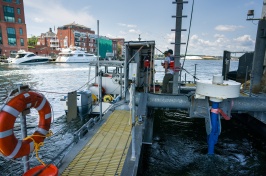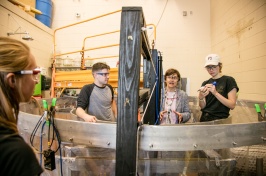UNH Research: Increased Crop Productivity Has Deepened Atmospheric "Breathing"

Multiple combine harvesters at work in a soybean field. Credit iStockphoto.com/alffoto.
Durham, N.H. -- A previously unexplained increase in Earth's annual atmospheric "breathing" cycle over the last 50 years is due in part to a dramatic rise in agricultural productivity in the Northern Hemisphere, according to a paper published today in Nature by a team of researchers that includes an Earth system scientist from the University of New Hampshire. The finding will help improve global climate models.
Each year, levels of atmospheric carbon dioxide (CO2) drop as plants photosynthesize during the growing season ("inhale"), and then climb again as plant litter decomposes in fall and winter ("exhale"). Although ground and aircraft measurements have shown that the seasonal rise and fall of Northern Hemisphere atmospheric CO2 concentrations has increased by as much as 50 percent over the last half century, the precise causal mechanisms behind the observed changes in CO2 seasonality have remained unclear.
"Most of the explanations put forward to date involve climate warming—particularly at high latitudes, a longer growing season, and greater plant productivity due to increasing atmospheric CO2, but those are only pieces of the puzzle," says coauthor Steve Frolking of the Earth Systems Research Center within the UNH Institute for the Study of Earth, Oceans, and Space.
While the Northern Hemisphere's photosynthetic season has been lengthening over the past three decades, enhanced photosynthesis in unmanaged ecosystems alone is not large enough to explain the increased CO2 amplitude—the total seasonal carbon exchange.
Adds Frolking, "Our research has shown that increases in agricultural productivity in the northern temperate zone, which have been largely overlooked in previous investigations, explain as much as 25 percent of observed changes in atmospheric CO2 seasonality, and perhaps more."
The increased agricultural productivity occurred from fairly constant crop areas and not an expansion of planted land area. In other words, the increase in yield is due to improved crop management, enhanced use of fertilizers, irrigation, and new plant varieties, etc.
Specifically, mid-to-high latitude corn, wheat, rice, and soybean production more than doubled between 1961-2008, thereby increasing the amount of net carbon uptake—the inhale of the biosphere's breathing—by croplands during the Northern Hemisphere's growing season. Corn alone accounts for two-thirds of this change, owing mostly to agricultural intensification within concentrated production zones in the Midwestern United States and Northern China.
"The fact that such a small land area can actually affect the composition of the atmosphere is an amazing fingerprint of human activity on the planet," notes Mark Friedl, a professor in Boston University's (BU) department of Earth and environment and senior author of the paper. Josh
Gray of BU, lead author of the paper, characterizes the croplands as "ecosystems on steroids" since they occupy just six percent of the vegetative land area of the northern hemisphere but are responsible for one quarter of the observed changes in CO2 seasonality.
While increased crop production does not have much impact on the long-term increase of CO2 in the atmosphere, understanding the effects of agricultural production, the researchers say, will help to improve models of global climate, which currently do not represent agricultural management very well.
The Nature paper, titled "Direct human influence on atmospheric CO2 seasonality from increased cropland productivity," includes coauthors from the universities of Michigan, Minnesota, Wisconsin-Madison, and McGill University. The research was funded primarily though programs supported by the National Science Foundation and NASA.
The University of New Hampshire, founded in 1866, is a world-class public research university with the feel of a New England liberal arts college. A land, sea, and space-grant university, UNH is the state's flagship public institution, enrolling 12,300 undergraduate and 2,200 graduate students.
-30-
Photograph to download:
http://www.eos.unh.edu/newsimage/combineharvesters_lg.jpg
Image caption: Multiple combine harvesters at work in a soybean field. Credit iStockphoto.com/alffoto.
Latest News
-
October 30, 2024
-
October 10, 2024
-
October 8, 2024
-
October 3, 2024
-
October 1, 2024
















































